Modern armies had never fought before on any field that was like the Aleutians.... We would have to learn as we went along, how to live and fight and win in this new land, the least-known part of our America.Cpl. Dashiell Hammett, author of the Maltese Falcon
75 Years Ago The Only Land Battle Fought on American Soil Took Place - Attu, The Aleutian Islands Alaska
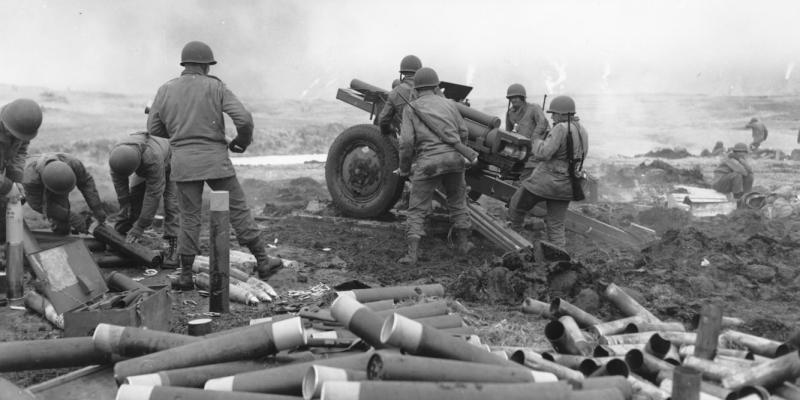

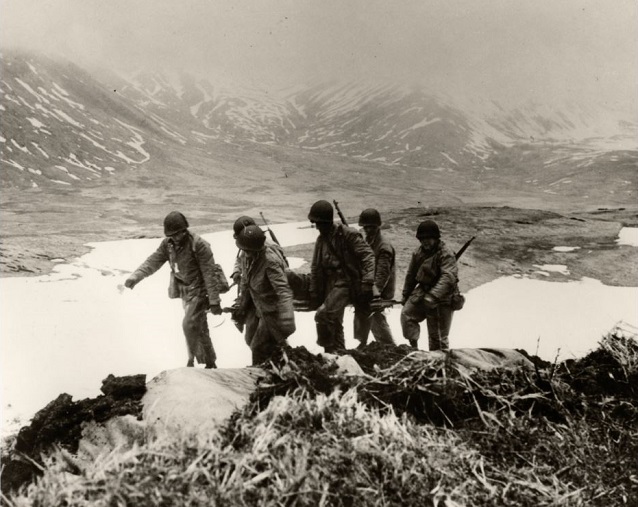 American troops transporting the wounded on Attu in May, 1943.
American troops transporting the wounded on Attu in May, 1943.Courtesy Hanna-Call Collection, University of Alaska Fairbanks
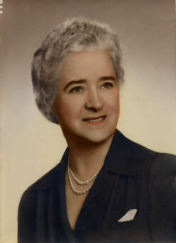 Etta Jones in 1953. Etta spent the war in a POW camp in Totsuka, Japan, and returned to the United States in 1945.
Etta Jones in 1953. Etta spent the war in a POW camp in Totsuka, Japan, and returned to the United States in 1945.Courtesy Mary Brue
The Invasion
From June 3 to 7, 1942, Japanese forces attacked Alaska’s Aleutian Islands, bombing Dutch Harbor on the island of Unalaska and invading the islands of Attu and Kiska. Attu’s radio operator, Charles Foster Jones, died during the invasion and his wife Etta, the island’s schoolteacher, taken prisoner. The Aleut (Unangan) residents of Attu were taken to Japan for the duration of the war. Of the 40 captives, 16 (40%) died from disease and starvation.
In May, 1943, after a prolonged air campaign, U.S. troops piled into transport ships to to expel invaders from American soil for the first time since 1812. Lasting 18 days, the Battle of Attu was one of the deadliest battles of World War II, but it remains one of the least well-known.
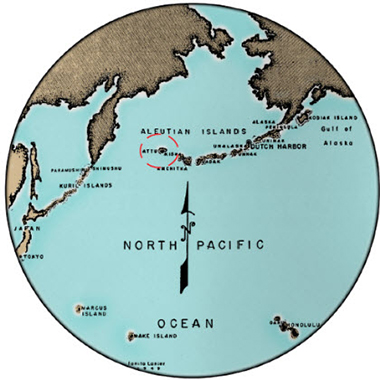 The arc of the Aleutians. Attu (the westernmost island in the chain) is circled in red.
The arc of the Aleutians. Attu (the westernmost island in the chain) is circled in red.The Army Air Forces in World War II
Retaking Attu
On May 11, 1943, 12,500 U.S. soldiers landed on the northern and southern ends of Attu Island. For over two weeks, battles raged over the tiny island. There were few large-scale engagements; as in the rest of the Pacific Theater, the Japanese preferred to employ “small group” tactics, using the rough terrain of Attu to their advantage and lying motionless for hours in foxholes until they could pin down American units with sniper fire. As they moved across the island, Americans had to search every hollow to ensure against surprise attacks.
“It was rugged...the whole damned deal was rugged, like attacking a pillbox by way of a tightrope...in winter.”
Lt. Donald E. Dwinnell
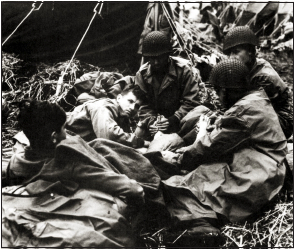 Soldiers rubbing the feet of a man suffering from "trench foot."
Soldiers rubbing the feet of a man suffering from "trench foot."Courtesy National Archives
In addition to constantly being on their guard against the Japanese, the Americans also had to contend with Attu’s weather. In fact, the weather was responsible for more American casualties than enemy fire. Over 2,100 American soldiers were taken out of action due to disease and non-battle injuries while nearly 1,700 were killed or wounded by the Japanese (see below for casualty figures). The Army had not taken the weather into account when they supplied the soldiers with their outdoor gear, and as a result many fell victim to exposure and suffered from frostbite and fever. Men who had no chance to change out of their sodden, poorly constructed boots for weeks endured “trench foot,” a condition caused by prolonged exposure to a cold, wet, and unsanitary environment. If untreated, trench foot could turn gangrenous and result in amputation. Japanese and American soldiers alike were scoured by 120 mile-per-hour winds, drenched by rain, and blinded by fog. Men had to keep moving to stay warm, even if it meant exposing themselves to enemy fire. Those who could not walk, crawled. When possible, the Americans took the superior clothing from dead Japanese soldiers, risking being shot by their own troops when they saw the enemy uniforms.
“The ones who suffered were the ones who didn’t keep moving.... They stayed in their holes with wet feet. They didn’t rub their feet or change socks....”
Captain William H. Willoughby
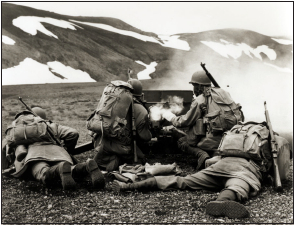 U.S. soldiers firing an anti-tank gun on Attu.
U.S. soldiers firing an anti-tank gun on Attu.Courtesy Alaska State Historical Library
When rations dwindled, soldiers on both sides began to go hungry. On the beaches, some American soldiers threw grenades into the ocean in the hopes of catching fish. Some units went without any food for days when supply planes could not locate them through the thick Aleutian fog. Some malnourished Americans overran Japanese positions after the enemy retreated and fought over the food and ammunition left behind. The Japanese survivors, deprived of their captured rations, began to starve. Dr. Paul Tatsuguchi, an American-trained Japanese medic, wrote in his diary on May 28, “Ate half-dried thistle. This is the first time I have eaten something fresh in months, it is a delicacy.”
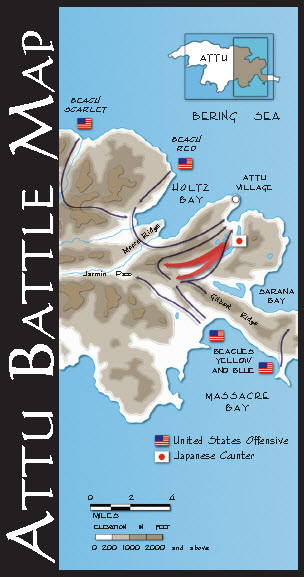 Map showing American and Japanese troop movements. The red lines show the Japanese movements on May 29, 1943.
Map showing American and Japanese troop movements. The red lines show the Japanese movements on May 29, 1943.Courtesy Archgraphics
Counterattack
In the evening hours of May 28, American forces occupied the high ground in Chichagof Valley, controlling three critical hills: Fish Hook, Buffalo, and Engineer. The Japanese forces were pushed to the sea, and the Americans planned to bombard them the next day. Colonel Yamasaki, the Japanese commanding officer on Attu, had 2,600 able-bodied soldiers when the Americans landed. On May 28, he had only 800 men available for combat, plus 600 men who had been wounded over the last two weeks of fighting. Rather than surrendering, which was considered dishonorable, Yamasaki chose to make a daring move. He and his men would counterattack the Americans at their weakest point, capture their artillery on Engineer Hill, and use it against them. They would then sweep through the island to Massacre Bay, raid the enemy’s supplies, and retreat into the mountains to await reinforcements. Most Japanese soldiers saw the plan as a chance for an honorable death, not a great victory. That night, Dr. Tatsuguchi recorded in his diary, “[there are]continuous cases of suicide….heard they gave 400 shots of morphine to kill wounded….”
“The last assault is to be carried out. All the patients in the hospital are to commit suicide. Only 33 years of living and I am to die here.... At 1800 (hours) took care of all the patients with grenades. Good-bye, Taeki, my beloved wife, who loved me to the last..”
Dr. Paul Nebu Tatsuguchi, May 28, 1943
At 3 a.m. on May 29, Company B of the U.S. 32nd Infantry received an order to march to battalion headquarters to get a hot breakfast, leaving a handful of sentries on guard. Suddenly, the Japanese attacked. Startled, many Americans retreated to the comparative safety of Fish Hook and Buffalo hills to regroup. Consequently, Yamasaki and his men were able to advance on the artillery on Engineer Hill without meeting any organized resistance.
“What a nightmare, a madness of noise and confusion and deadliness.”
Capt. George S. Buehler reflecting on May 29, 1943
A small number of noncombatant units were stationed on top of Engineer Hill. Under the command of General Archibald V. Arnold, they quickly organized a defense made up of medics, engineers, and service personnel who began hurling hand grenades at the Japanese. Unfazed, the Japanese continued to advance, and desperate hand-to-hand combat erupted as the defenders fought for their lives. The tide turned when the 50th Engineers arrived and forced the attackers back with bayonets and rifle butts, preventing them from reaching the critical artillery. Although the battle continued throughout the day, the Japanese were not able to mount another concentrated attack. Colonel Yamasaki was killed late in the day as he led another wave up Engineer Hill.
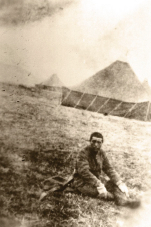 One of only 28 Japanese prisoners of war taken on Attu.
One of only 28 Japanese prisoners of war taken on Attu.Courtesy Museum of the Aleutians
The Bushido Code
The Japanese armed forces followed a Samurai warrior code, known as the "Bushido Code." Bushido condemned weakness and extolled battle, bravery, loyalty and obedience. Surrender was profoundly dishonorable, and soldiers were instructed to commit suicide rather than be captured. If a soldier chose to surrender, his dishonor spread to his family; some wives of POWs killed themselves to escape the shame brought on them by their husbands.
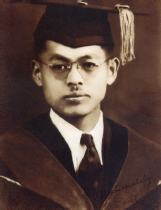 Paul Nebu Tatsuguchi at his graduation from medical school.
Paul Nebu Tatsuguchi at his graduation from medical school.Courtesy Loma Linda University, California
Dr. Paul Nebu Tatsuguchi
Much of what is known about the daily life of Japanese soldiers on Attu comes from the war diary of Paul Nebu Tatsuguchi. Tatsuguchi studied medicine in California before the war. He converted to Christianity and served as a medical missionary of the Seventh Day Adventist Church in Japan before being drafted into the Imperial Army in 1941. Tatsuguchi died on May 29 when his field hospital was overrun by U.S. troops.
Read an excerpt from Dr. Tatsuguchi's diary at:
http://www.hlswilliwaw.com/aleutians
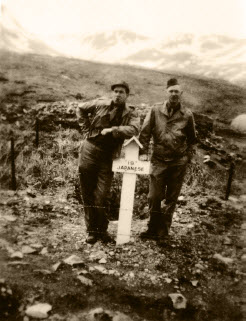 PFC John J. Busteed (right) and a friend standing next to a Japanese grave on Attu, c. 1940s.
PFC John J. Busteed (right) and a friend standing next to a Japanese grave on Attu, c. 1940s.Courtesy John J. Busteed Collection, NPS
The Aftermath
On May 30, only 28 of the roughly 1,400 Japanese who had been in the valley the day before survived. The rest had been killed in battle or had committed suicide by holding hand grenades to their chests. When the Americans came across the Japanese hospital tents, they made the horrific discovery that all of the wounded had been killed by their doctors. The Americans buried 2,351 Japanese in mass graves on Attu, and it is thought that several hundred more were buried in the hills.
The Battle of Attu ranks as the second deadliest battle in the Pacific Theatre (in proportion to the number of troops engaged) falling just behind Iwo Jima. The first combatrelated exposure suffered by American forces in World War II occurred on Attu. As a result, major changes in Army footwear, outdoor gear, tents, and food occured. The Battle of Attu also caused the Japanese Imperial Navy to briefly redistribute their forces in the Pacific in May, 1943 to protect Japan. U.S. forces took advantage of the depleted Imperial Navy strength in the South Pacific and made significant gains in the Solomon Islands.
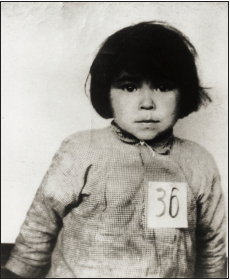 Attuan child and prisoner of war, 1952.
Attuan child and prisoner of war, 1952.Courtesy Alaska State Historical Library
When the surviving Attuans were released by Japan in 1945, they embarked on a long journey home via the Phillipines, San Francisco, and Seattle. When they reached Seattle, they were told that they would not be allowed to return to Attu, as the U.S. government had decided that the cost to rebuild their devastated village was prohibitive.
The battlefield area on Attu was designated a National Historic Landmark in 1985. The U.S. Fish and Wildlife Service owns and manages Attu as a part of the Alaska Maritime National Wildlife Refuge.
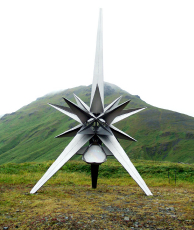 A Peace Monument on Attu honors all those who died in the Aleutian Campaign. The titanium monument was erected by the Japanese Government in 1987. In 2003, after being damaged in a storm, it was restored by a team of Japanese and American metal technicians.
A Peace Monument on Attu honors all those who died in the Aleutian Campaign. The titanium monument was erected by the Japanese Government in 1987. In 2003, after being damaged in a storm, it was restored by a team of Japanese and American metal technicians.Courtesy U.S. Coast Guard
Casualties on Attu
Japanese
2351 Dead
28 Captured
American
549 Dead
1148 Wounded
1200 Severe cold injuries
614 Disease (including exposure)
*Source: John Cloe (1990, 293)








The Aleut (Unangan) residents of Attu (Americans) were taken to Japan for the duration of the war. Of the 40 captives, 16 (40%) died from disease and starvation.
Sadly the Aleut people would never see then home island again.
A little know part of WWII, but very important in more ways than one.
Kudos to the 7th Infantry. Without proper clothing and equipment, suffering from bitter cold they prevailed at a horrible cost.
Another horror story about WWII. Just when I think I've heard them all, I learn a new one.
Did the Attuans ever find a place to call home again or just where they were deposited?
After the Japanese were defeated and driven out of the Aleutians the Aleut people were held in interment camps and forced labor until the end of the war in 1945.
They returned to their villages, with the exception of Attu which was held off limits to them. The homes had been ransacked and mostly destroyed. It wasn't until 1980 that the US government awarded the Aleuts that were still alive $12,000 as compensation.
Another really sad chapter in US history with the treatment of Indians.
That's just a bucket of piss.
This give me a burr under my butt.
I am sure the expense to replace the war ravaged Frank Loyd Wright homes of the native inhabitants of Allut would have sunk the national dept.
For anyone reading along, yes, that is sarcasm.
Yeah, pretty damn sad isn't it dave.
Terrifying.
Great seed, K.
Thanks Bob.